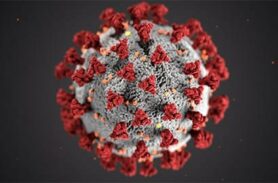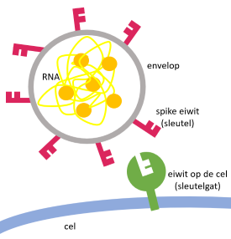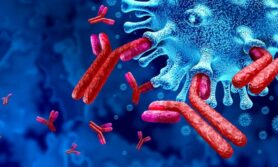How small can we go?
THE key of the coronavirus

The SARS-CoV-2 virus with spike proteins in red
(CDC/ Alissa Eckert, MS; Dan Higgins, MAM, public domain via Wikimedia Commons)
There is a lot in the news about the British variant of the coronavirus SARS-CoV-2. This variant causes the contamination numbers to rise quickly and caused schools to close. An important reason this variant can spread so quickly is a change in the spike protein of the virus. This spike protein is extremely important for the spread of SARS-CoV-2. In Utrecht, the research group of Dr. ir. Berend Jan Bosch is conducting a lot of research into the spike protein.

The corona virus binds to a protein on the cell (lock) with its spike protein (key)
The SARS-CoV-2 virus consists of a piece of hereditary material, RNA, surrounded by an envelope of proteins. One of those proteins called the spike protein sticks out of the virus. This spike protein is on the outside of the corona virus and can be seen as a kind of key. With this key, the virus binds to a protein, the lock, on the host’s cell and ensures that the cell opens and the virus can enter. As soon as the virus enters the cell, the RNA is released. You can see this RNA as a cookbook for a new virus. The virus “hacks” the cell and causes it to make recipes from that cookbook. With this, the virus ensures that many new virus particles are made within a few hours of arrival.
According to Berend Jan Bosch, the most important development of the last years in virology, is the analysis of viruses with electron microscopy. With this technique you can look at very small things with great sharpness. “Thanks to technical improvements, we are now much better able to obtain a high-resolution image of what viruses and their proteins look like.” Together with researchers in America, Berend Jan Bosch was the first to get a 3D image of the spike protein of a coronavirus. These images are very important because we can find out what the vulnerable spots are in the virus. We can use those places to make inhibitors for the virus.

Antibodies bind to spike proteins of SARS-CoV-2 (Lightspring / Shutterstock)
Berend Jan Bosch uses this knowledge about spike proteins. By doing a lot of research, he has found a place in the spike protein of SARS-CoV-2 that will not change quickly when new variants appear. In the past year, he has published two studies on antibodies that bind to such sites. These antibodies block the entry of SARS-CoV-2 into the host cell and can thus help prevent infections. In fact, one of these antibodies is currently being tested in patients!
Such antibodies can mean a lot to us even if there are vaccinations. “Antibodies remain important in preventing infections in people who have not yet been vaccinated or who do not respond well to vaccines due to underlying medical causes. The antibody we have developed is special because it binds to a spot on the spike protein that is well conserved. This keeps it more effective against the variants that are currently occurring.”
In addition to continuing to work well against SARS-CoV-2 variants, these antibodies may also work in future outbreaks of similar coronaviruses. So far, there have been three major coronavirus outbreaks and SARS-CoV-2 is unlikely to be the last. Much research is still needed to prepare for a future outbreak. People from many different fields work together within the group of Berend Jan Bosch. For example, people are needed with knowledge about genetics, molecular virology and structural virology, as well as people who can perform animal experiments.
Did you know that the spike protein is so characteristic of coronaviruses that they even get their name from it? The spike proteins on the outside of the virus are reminiscent of a crown, or corona in Latin.
The spike protein is not only the key for coronaviruses to enter our cells, but is also the key that researchers can use to prevent infections. By researching the spike protein, it has been possible to find an antibody that not only blocks SARS-CoV-2, but that may also prevent infections of future coronaviruses.
Do you want to know more about the biology of small things? Then read Marieke’s article about how we can use things that can sometimes make us sick, such as bacteria, as a cure for diabetes. Would you like to know more about electron microscopy? Then view Max’s blog article. Would you rather learn about how we can use algorithms to improve microscopy images? Then look at Abe’s blog article!
Sources:
Walls, A., Tortorici, M., Bosch, BJ. et al. Cryo-electron microscopy structure of a coronavirus spike glycoprotein trimer. Nature 531, 114–117 (2016). https://doi.org/10.1038/nature16988
Wang, C., Li, W., Drabek, D. et al. A human monoclonal antibody blocking SARS-CoV-2 infection. Nat Commun 11, 2251 (2020). https://doi.org/10.1038/s41467-020-16256-y
Wang, C., van Haperen, R., Gutiérrez-Álvarez, J. et al. A conserved immunogenic and vulnerable site on the coronavirus spike protein delineated by cross-reactive monoclonal antibodies. Nat Commun 12, 1715 (2021). https://doi.org/10.1038/s41467-021-21968-w

